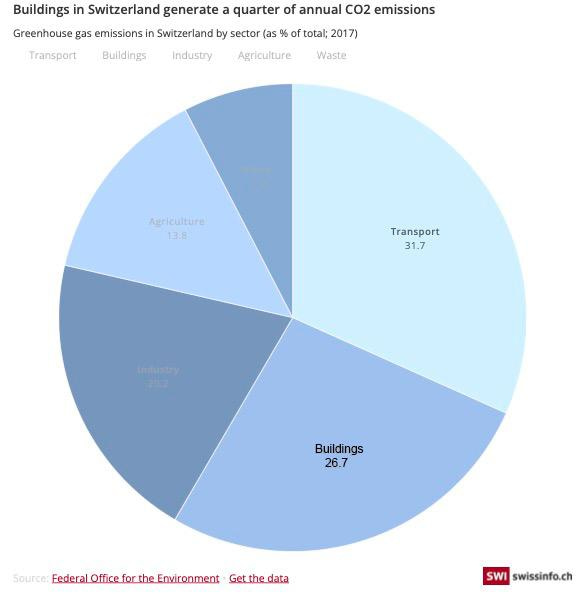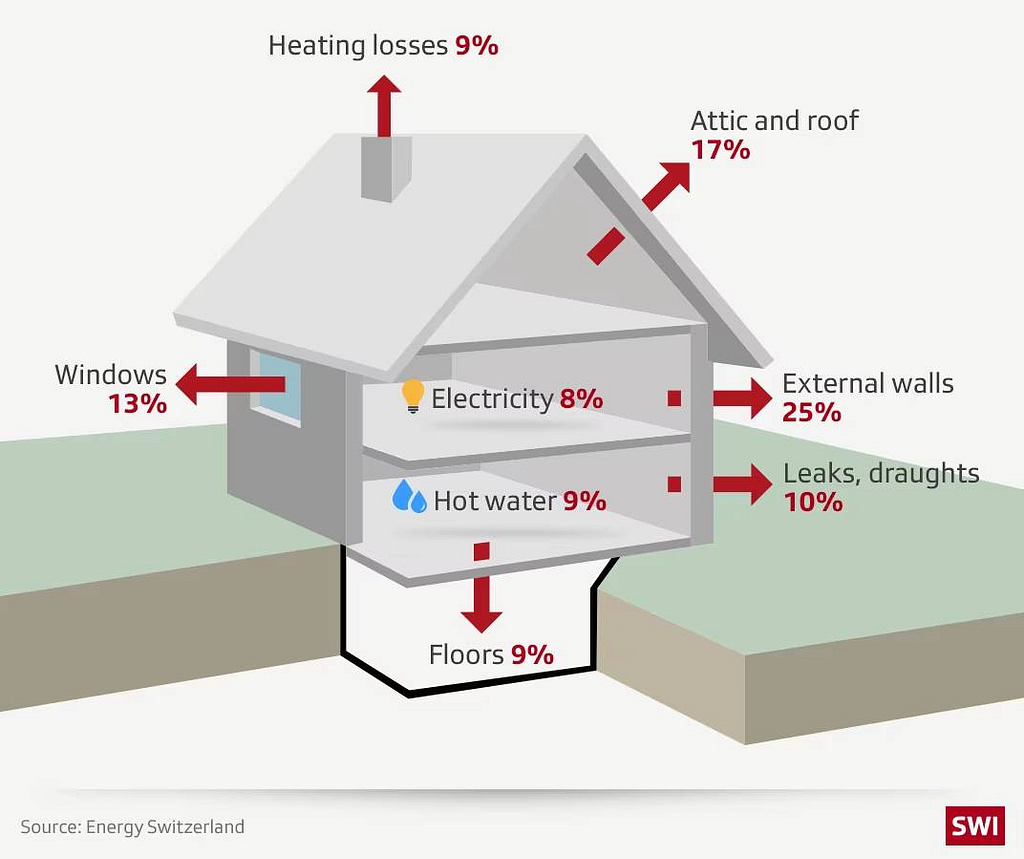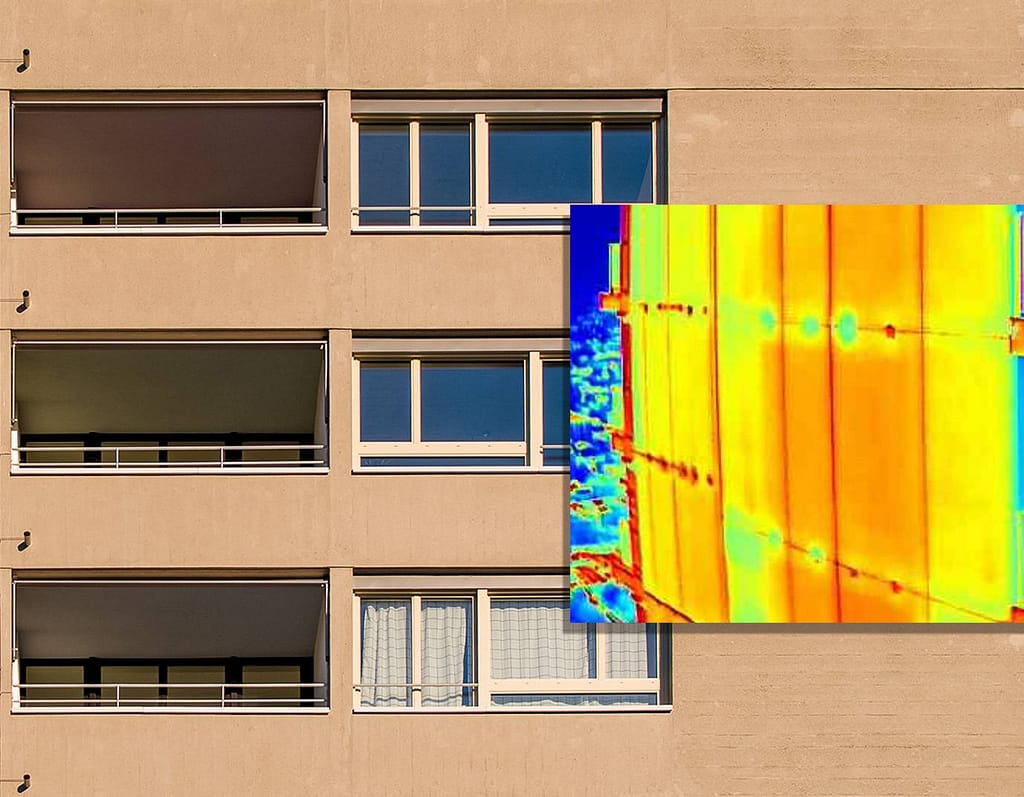In the global pursuit of a sustainable future, many nations are actively championing ambitious initiatives to combat climate change. Pioneering environmental conservation efforts have been marked by policies such as the European Green Deal and Switzerland’s Energy Strategy 2050. Despite these commendable strides, a crucial yet often overlooked aspect is the influence of building envelope defects on energy wastage and climate change. This article explores the significance of building envelope integrity on energy loss and greenhouse gas emissions, and emphasizes the urgent need for comprehensive, periodic inspections to address these issues.
The Problem: Energy loss and emissions from buildings.
A recent study by the European Commission suggests that buildings account for up to 40% of Europe’s overall energy consumption. The Swiss Federal Office of Energy states that buildings consume nearly the same proportion in Switzerland. Moreover, in 2017, the Swiss Federal Office for the Environment (FOEN) found that buildings were responsible for about 27% of Switzerland’s total CO2 emissions, surpassing industrial emissions at 20% and closely trailing the transportation sector at approximately 32% (Fig. 1). These statistics emphasize the crucial role that energy inefficiency in buildings plays in the ongoing battles against energy wastage and climate change.

Figure 1: FOEN chart presenting Switzerland 2017 CO2 emissions by industry sector.
The European Green Deal and Switzerland’s Energy Strategy 2050 set ambitious schedules for achieving climate neutrality. Recognizing that efficient buildings are integral to this goal, a relatively successful part of their emphasis is placed on reducing carbon footprints and energy consumption in the construction of new buildings. The picture is less encouraging, however, with respect to the numerous older structures scattered across the continent. For example, the Swiss National Science Foundation
(SNSF) reports that only a mere 1% annually of existing buildings in Switzerland undergoes renovation in an effort to enhance energy efficiency. This figure falls far short of meeting the requirements outlined for buildings in the Energy Strategy 2050 program, highlighting a pressing need for increased commitment to the pursuit of energy-efficient renovations of the existing buildings stock.
Data sourced from the Energy Switzerland program of the Swiss Federal Office of Energy highlights the substantial impact of building envelopes, revealing that they can contribute to as much as 65% of the energy losses in a given structure (aggregating all individual “through the envelope” losses as modeled for a single-family-home: Fig 2).

Figure 2: Energy Switzerland/SWI diagram presenting energy losses from a typical single-family home in Switzerland.
Older buildings are particularly likely to need attention to their envelopes. The building envelope, comprising walls, roofs, windows, and doors, acts as a crucial energy barrier. Defects in this envelope, such as poorly sealed windows, inadequate insulation and even cracks in the walls, developed over time, lead to energy inefficiencies and increased greenhouse gas emissions. Switzerland and Europe have vast numbers of such buildings, some of which are centuries old and most of which are in need of careful, energy-minded renovations. Additionally, according to swissinfo.ch, two-thirds of houses currently standing in Switzerland were constructed before 1980, suggesting that the need for energy renovations for buildings only a few decades old is an even larger issue.
The Solution: Timely, comprehensive inspections guiding effective repairs.
Thorough and meticulous building inspections serve as a crucial defense against energy and emissions inefficiencies. Detecting and identifying problems early helps minimize their impact by allowing for timely and efficient implementation of necessary repairs. Furthermore, committing to regular and periodic assessments represents a proactive strategy that yields substantial dividends over the long run. By consistently monitoring the condition of the building envelope over time, owners can keep track of potential problems and make informed decisions that result in significant savings on operational costs.
In fact, however, many buildings are not easily inspected, due to their size or height. Inspections of building exteriors have traditionally been performed by means of a combination of approaches, to include attempting to look for defects with binoculars, which is inconsistent at best, and by erecting scaffolding to reach high places, which is both expensive and potentially dangerous to workers. No doubt many building owners and managers have found these options discouraging, and this is certainly at least part of the cause of the low renovations rates reported by the SNSF.
Alternatively, the use of modern, sophisticated drones presents a new, safe and reliable solution for building inspections. Drones have the capability to ascend to any height a building might reach, making them adept at conducting thorough examinations of the entire exterior. Some of the newest models possess fully automated flight and proximity-sensing capabilities that assist in performing inspections flights. Coordinating the great numbers of images that must be taken in order to achieve a comprehensive examination of a building’s envelope, however, remains a challenge.
We can do this for your building.
The Swiss-registered firm Parhelion Aerospace GmbH and the American firm Inspekt AI, working together are able to effectively and efficiently achieve this level of aerial inspections service in Switzerland. Utilizing modern, sophisticated and safe drones, Parhelion captures both visual and thermal infrared imagery of your building. Inspekt AI thereafter employs its proprietary AI program, adept at coordinating thousands of images, to conduct a thorough defects analysis. Inspekt AI then stores the results in a client-accessible online account that permits owners and managers to monitor their building’s condition over time as inspections are repeated. This innovative approach guarantees comprehensive and precise results, providing definitive insights that serve as a reliable guide for effective repairs that reduce energy inefficiencies and greenhouse gas emissions.
Prioritizing building envelope inspections directly contributes to the broader goals of a greener, more sustainable future. To schedule a 21st-century inspection of your building, feel free to contact Parhelion or Inspekt AI. We are committed to working with you to meet your inspection needs in Switzerland.
References:
1. “Commission welcomes political agreement on new rules to boost energy performance of buildings across the EU” European Commission website, New rules to boost energy performance of buildings page, 7 December, 2023.
2. “Buildings” Swiss Federal Office of Energy website, Buildings page, 2024.
3. Swiss Federal Office for the Environment website, Environmental reports, 2007-2018.
4. “Building renovation needs to be speeded up – synthesis on the main topic of “Buildings and Settlements”” Swiss National Science Foundation, NRP 70 Newsletter, 17 October 2019.
5. “Why most Swiss buildings are environmentally inefficient” Luigi Jorio, swissinfo.ch, 15 January 2020.
6. “From old to new – building renovations visualized” energieschweiz (Energy Switzerland) website, Tools and Calculators page, 2024
